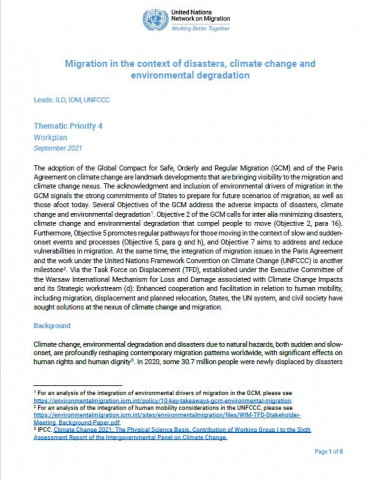Library
Workplan- Thematic Priority 4 on Migration in the Context of Disasters, Climate Change and Environmental Degradation
The adoption of the Global Compact for Safe, Orderly and Regular Migration (GCM) and of the Paris Agreement on climate change are landmark developments that are bringing visibility to the migration and climate change nexus. The acknowledgment and inclusion of environmental drivers of migration in the GCM signals the strong commitments of States to prepare for future scenarios of migration, as well as those afoot today. Several Objectives of the GCM address the adverse impacts of disasters, climate change and environmental degradation1. Objective 2 of the GCM calls for inter alia minimizing disasters, climate change and environmental degradation that compel people to move (Objective 2, para 16). Furthermore, Objective 5 promotes regular pathways for those moving in the context of slow and sudden-onset events and processes (Objective 5, para g and h), and Objective 7 aims to address and reduce vulnerabilities in migration. At the same time, the integration of migration issues in the Paris Agreement and the work under the United Nations Framework Convention on Climate Change (UNFCCC) is another milestone2. Via the Task Force on Displacement (TFD), established under the Executive Committee of the Warsaw International Mechanism for Loss and Damage associated with Climate Change Impacts and its Strategic workstream (d): Enhanced cooperation and facilitation in relation to human mobility, including migration, displacement and planned relocation, States, the UN system, and civil society have sought solutions at the nexus of climate change and migration.
